The ghost town surrounded by ocean
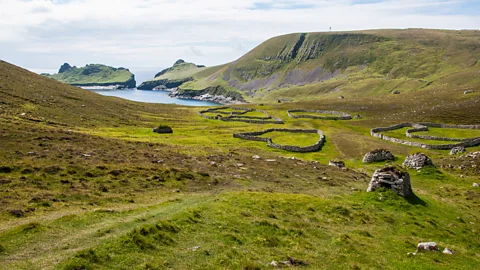 Amanda Ruggeri
Amanda RuggeriThe most remote of the British Isles is home to northwest Europe’s largest seabird colony, cliffs taller than the Empire State Building – and to one of the world’s eeriest ghost towns.
There are few places left in the world – particularly in Britain – that remain so isolated, so inaccessible, that your journey plans can be completely thrown by the wind or weather.
St Kilda is one of those rare places. Located 40 miles west over open Atlantic waters from the next inhabited piece of land – the already remote island of North Uist – the archipelago marks the outermost edge of Scotland’s Outer Hebrides and the most far-flung part of the British Isles. It’s so distant, it’s often not shown on maps of Britain; so small, it’s usually left off of maps of Europe or the world, too.
It’s also the home of a ghost town. Hirta, St Kilda’s main island and the only one of the four to ever be inhabited, was abandoned by its last residents in 1930. It was the end of an era, one that recently closed even more definitively: the last of the St Kildans died in April of this year. The village is now maintained by the National Trust for Scotland as a heritage site.
The only way to get to St Kilda is by boat. But as any sailor knows, the ocean has its own designs. The week I was meant to leave from the Isle of Skye, the captain, Derek, emailed me travel forecasts, each one worse than the one before. The last one, a map, showed a swirl of red pulsing around our route. “Red is bad!” he typed.
The Wednesday trip I’d booked was cancelled; so was the one on Thursday.
 Amanda Ruggeri
Amanda RuggeriOn Friday, I woke up to dawn pinking through slate-grey clouds – and to confirmation that the trip was on.
By 7 am, our group of 12, wrapped in waterproofs and clutching canteens of coffee, left the harbour of Uig. A light rain began to sprinkle as the white houses and hills of the Isle of Skye receded behind us. An hour went by, an hour and a half.
“Those are the last few islands now,” Derek said. We still had two hours to go.
 Amanda Ruggeri
Amanda RuggeriThe archipelago’s remote location has never stopped visitors. People ed through St Kilda as early as 7,000 years ago; excavations have turned up Neolithic stone tools and a potential Bronze Age burial mound. The Vikings ed through in the 9th and 10th Centuries, leaving behind brooches and a sword. By the 17th Century, Hirta had a community of 180, served by three chapels – a surprisingly high number that some researchers think points, perhaps, to St Kilda being settled by Early Christian monks.
The archipelago’s location has also helped make it the largest seabird colony in the northeast Atlantic, home to about a million birds, including the world’s largest colony of gannets and the EU’s largest colonies of both puffins and fulmars. Sadly, these birds are in danger. Thanks to food shortages and other results of climate change, their numbers have dropped up to 90% in 15 years.
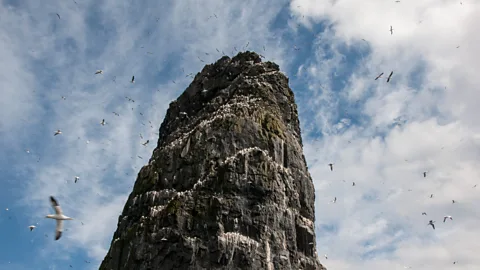 Amanda Ruggeri
Amanda RuggeriThat devastation makes it even harder to imagine just how many there would have been in the time of the St Kildans. As we circled Hirta and the nearby isle of Soay, the cliffs were lined with so many birds that the rock ledges looked frosted. Four miles to the northeast, at the tallest sea stack in Britain – at 196m (643ft) tall, more than twice the height of Big Ben – gannets swirled so thickly they looked like a swarm of bees.
These birds were how the St Kildans survived. As well as eating them (they rarely consumed fish), the islanders also sold, or provided as payment to the island’s landlord, every part – from feathers to oil to flesh. In 1876 alone, they hunted 89,600 puffins.
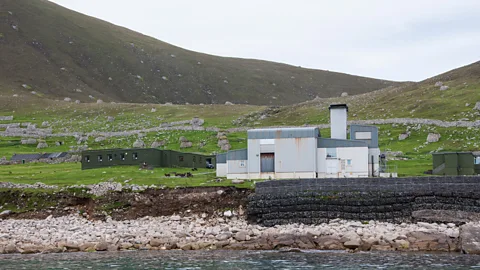 Amanda Ruggeri
Amanda RuggeriNow, coming up to Hirta, we could see the other benefit of the location. Surprisingly modern buildings spot the island – military installations run by the Ministry of Defence that include lodging, messes and a communications centre, all off limits to the public.
“What they say is that they're monitoring the missile testing from Benbecula,” said Derek, referring to test launches that happen from an island 40 miles away. “But I'm quite sure they're doing a lot of other things we don't know about as the last outpost of the British Isles.”
The military facilities only added to the island’s feeling of mystery. Nothing, though, was as eerie as the abandoned village.
 Amanda Ruggeri
Amanda RuggeriFor an island surrounded by so little, the village seemed surprisingly large. Most of the 40 stone homes lined a main path dubbed “The Street”, shown above. Slate placards stood in front of some huts, neatly lettered in memory of the last inhabitants.
Where residents would have once walked, delicate sheep – St Kilda’s primitive Soay breed, which date back some 4,000 years – skittered through overgrown grass.
 Amanda Ruggeri
Amanda RuggeriAlthough the ruins may seem romantic, life here would have been anything but. Working the land – which lacks so much as a tree – was difficult. Winter brought bitter cold and lashing storms. Even seabird hunting, the staple of St Kildan life, was challenging: the birds only stayed on the archipelago half the year, during which the locals hunted them by dangling over sheer cliff edges by a rope, reaching out with snares or their bare hands.
But the St Kildans devised ingenious ways of surviving. The stone huts (pictured below) built in the 1830s, known as “blackhouses” like similar structures built elsewhere in the Scottish Highlands, were each dug a metre deep into the ground for insulation. The roofs were thatched, then waterproofed with tar and turf.
And livestock – often a cow and a couple of sheep – were brought indoors, a smart, if smelly, way to keep the house warm. As well as using the animals’ body heat, the St Kildans would spread the animals’ manure – along with their own waste, including both excrement and discarded bird carcasses – over the floor.
“It would be like under floor heating. Just not very posh,” our guide Nicola joked.
 Amanda Ruggeri
Amanda RuggeriBy the end of the winter, the floor rose so high that visitors had to crawl through the door on their knees. Come spring, they’d dig it out and spread it on their fields: the perfect fertiliser.
While the St Kildans were self-sustaining, they weren’t exempt from modern life. Like many other parts of Scotland, they were under the rule of a distant landlord, or laird, who lived on the mainland. Most of the birds went to him as payment.
But by the late 19th Century, more and more tourists visited St Kilda. And the islanders’ way of life became an embarrassment, both to Victorian do-gooders and to the Clan MacLeod laird.
In the 1870s, using donations from well-meaning outsiders, the clan’s island steward built the St Kildans new homes, pictured below. They were modern, just like those on the mainland – and completely unsuitable for St Kilda life. The tin roofs haemorrhaged heat and let in water. The imported materials couldn’t be replaced when something broke. And instead of being corner-on into the brutal southeasterly that could reach up to 160mph, the new homes faced the harbour – and the wind.
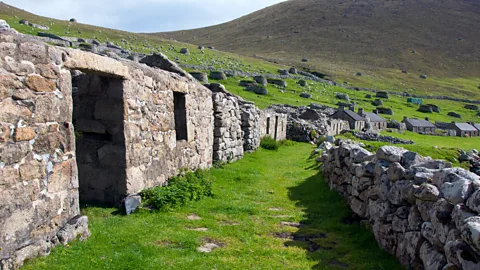 Amanda Ruggeri
Amanda RuggeriDuring the first storm, windows and doors flew off their hinges and roofs blew off. Locals moved back into the blackhouses. After the steward tried building a 6ft wall and bolting down the roofs, the islanders were ordered to move back into the new homes. They were also told not, under any circumstances, to bring their animals inside. As soon as the cold hit, many disobeyed. Their bid for survival can still be seen today: the nettles growing inside the abandoned homes result from the ammonium and nitrate of cattle urine.
By 1930, these attempts at “modernisation”, along with the St Kildans’ growing awareness of what life was like elsewhere, led to a request from the last 36 residents. They asked the British government to resettle them.
But as much as they knew it was the right decision, many of the residents hesitated over g the letter.
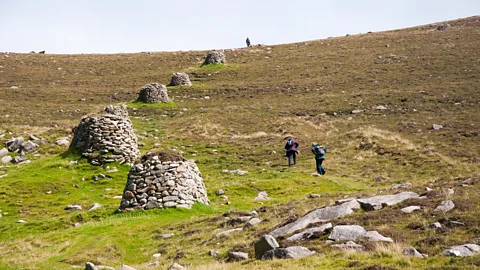 Amanda Ruggeri
Amanda RuggeriI could see why. Leaving the village behind, I walked up the hill to the north, weaving my way through countless cleits, the hand-hewn, turf-covered stone sheds that St Kildans used to keep seabirds and crops cool and dry.
 Amanda Ruggeri
Amanda RuggeriAt one of the long-empty livestock enclosures, I stopped and looked back. From here, the harbour was just a slash of aqua far below. The village disappeared completely. It was easy to feel – just for a moment – like St Kilda could be the one place in the world that stood outside not only of most maps, but, even, of time itself.
This story is a part of BBC Britain – a series focused on exploring this extraordinary island, one story at a time. Readers outside of the UK can see every BBC Britain story by heading to the Britain homepage; you also can see our latest stories by following us on Facebook and Twitter.
